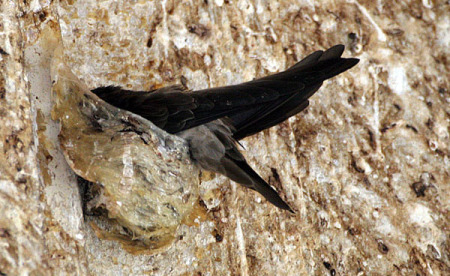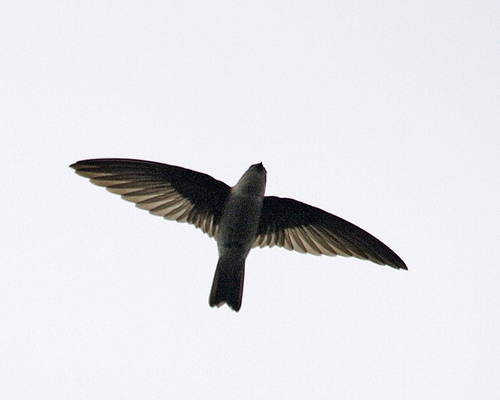
Aerodramus fuciphagus
SUBFAMILY
Chaeturinae
TAXONOMY
Hirundo fuciphaga Thunberg, 1812, Java. Eight subspecies.
OTHER COMMON NAMES
English: Gray-rumped swiftlet, white-nest swiftlet, Hume’s
swiftlet; French: Salangane а nid blanc; German: WeiЯnestsalangane;
Spanish: Salangana Nidoblanco.
PHYSICAL CHARACTERISTICS
4.6 in (12 cm); 0.4–0.6 oz (10–15 g). Glossy blackish brown
upperparts sometimes with lighter rump; underparts are mostly
brownish gray with lighter throat and blackish undertailcoverts.
DISTRIBUTION
Southeast Asia and Indonesia, from Andaman and Nicobar Islands
through coastal south Thailand, Malaysia, Sumatra, Java,
and Borneo to Lesser Sundas.
HABITAT
Widespread in coastal lowlands but in some places at elevations
to 3,280–9,000 ft (1,000 to 2,800 m). Coastal mangroves,
cultivated areas, and lowland forest.
BEHAVIOR
Gregarious and often associates with other swiftlets and swallows
when foraging.
FEEDING ECOLOGY AND DIET
Aerial arthropods, including a wide array of insects and spiders.
REPRODUCTIVE BIOLOGY
Breeding season is lengthy and peaks in the dryer season of the
year. Nests are self-supporting brackets made almost completely
of the sticky salivary mucilage. Usually two eggs are
laid and incubation period is 25.5 days for the first egg and
22.5 days for the second; the fledging period is 43 days.
CONSERVATION STATUS
In areas where unregulated repetitive nest harvesting is taking
place, populations as well as harvesting yields are sharply declining
by as much as 85% over a 12-year period.
SIGNIFICANCE TO HUMANS
Nest-harvesting provides substantial economic benefits to local
human populations.
Photo Gallery of - Edible-nest swiftlet




 Animalia Life
Animalia Life